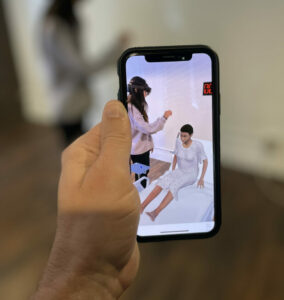This article has been revised and corrected from the original version.
Westchester-based GigXR Inc. is using Microsoft Corp.’s HoloLens smartglasses to immerse students in patient-simulation scenarios, hoping to change how medical professionals are trained.
GigXR was founded in 2019 when the company acquired immersive learning assets from Pearson, including HoloPatient and HoloHuman. Both use mixed reality to create immersive training sessions.
HoloHuman is a human anatomy atlas that uses full-sized holograms to study different regions of the human body, while HoloPatient is an application that allows medical students to assess, diagnose and treat patients through holographic simulations of different scenarios.
When accessing a lesson through HoloPatient, a student will see a hyper-realistic hologram of a patient that can be placed anywhere in the room. The student can then walk around the patient, assess their symptoms, diagnose them and decide upon a course of treatment.
GigXR began operating just before the onset of the Covid-19 pandemic, and took what could have been a major setback for the company and spun it around by building a remote layer.
In October 2020, GigXR released two apps — HoloPatient Mobile and Gig Mobile — to the iOS and Android stores as a way to let students learn in a safe, socially-distant environment.

David King Lassman, the company’s founder, said while the technology can be applied to various industries, GigXR’s mission is to raise medical standards and transform how medical students receive their training at hospitals and medical and nursing schools.
Raising medical standards
The platform works as a subscription service for medical schools, which gain access to a variety of training lessons and simulations.
Licenses to use the product can range from $10,000 to six figures depending on the number of applications and users.
“We’re similar (to Netflix Inc.) in the sense that a school will subscribe to our platform and then be able to pick from a growing catalog of applications that sit on the platform,” Lassman said. “Those applications are either built by us exclusively or we build them in collaboration with great institutions like Cambridge University. Or they’re built by third parties … That’s valuable from an end user’s perspective because the user only needs one platform that handles all their credentialing, logins, passwords, setting-up sessions, pulling in content in this sort of rinse-and-repeat fashion.”
L.A. is really important techological hub.
DAVID KING LASSMAN
GIGXR
Lassman said the role that simulation plays in training nurses and doctors is very important. Normally, these types of lessons would be taught with the use of cadavers and other practice kits. The company entered the educational space at a time when cadavers were limited because fewer bodies were being donated to medical research, and when practice mannequins were too expensive for small schools to purchase, Lassman said.
“These are really expensive pieces of analog technology, and you need a big brick-and-mortar building to house all that technology in. And if you’re a small provincial school, you might not have those resources at your disposal,” Lassman said. “So, what mixed reality does is it presents an opportunity for schools and their students to interact with simulation models, but at a low cost.”
With the pandemic forcing students to learn from home, missing out on simulation training would be detrimental to their education, Lassman said.
“If you’re a student studying in your parent’s basement in Wyoming and your school is in Los Angeles, you can log into a lesson and you see all of that content right there in the room that you’re in as part of an instructor-led session,” Lassman explained. “Hearing your teacher through your device, being able to interact with your teacher, being able to interact with your peers.”
It’s not only about learning remotely; Lassman described this teaching method as creating a “paradigm” where medical students on one side of the world can learn with students and teachers on the opposite side.
“When you start to think about the challenges that are faced in countries in sub-Saharan Africa, for instance, like Uganda or Botswana, where there’s a dearth of doctors being pushed out into the communities before they’re sufficiently trained, where routine procedures in the West become life or death procedures there,” Lassman said. “If we can help train those doctors using tools like holographic content delivered through mixed reality, we can help raise standards. That is the way we’re going to make a big difference.”
Local focus
GigXR currently has 60 customers across four continents and hopes that more schools and training hospitals in the Los Angeles area will not only become customers, but partners.
“Our customers will buy licenses to our platform and subscribe to a bunch of applications in order to drive curriculum at the school,” Lassman said. “A partner is a school, an institution that we strategically partner with to build content. These are commercial endeavors. We partner with a group like University of Michigan School of Medicine. We build product, sell product and share the revenue with them.”
Most recently, GigXR partnered with the University of Cambridge and Cambridge University Hospitals NHS Foundation Trust to create holographic scenarios for common respiratory conditions and emergencies.

“Partnering with GigXR allows us to create robust training without the heavy resource demands of traditional simulation, which can make immersive training financially prohibitive due to costs for maintaining simulation centers, their equipment and the faculty and staff hours to operate the labs and hire and train patient actors,” Mary Archibald, director of operations at the Surgical Training Centre and medical education manager at Cambridge University Hospitals NHS Trust, said in a statement.
Despite being a global company, Lassman said he is excited to expand throughout Los Angeles.
“We’re a platform, but we’re kind of telling stories through these scenarios, through these little vignettes that help students learn, and L.A. is the world’s capital of storytelling,” Lassman said.
Lassman continued to explain that while Los Angeles used to be the “poor neighbor” to the Silicon Valley when it came to the region’s technology sector, that’s changed recently.
“I’ve been in Los Angeles for 20 years now, and I’ve seen the tech scene evolve,” Lassman said. “I think increasingly we’re telling the world, ‘Hey, this is a really important technological hub.’”
